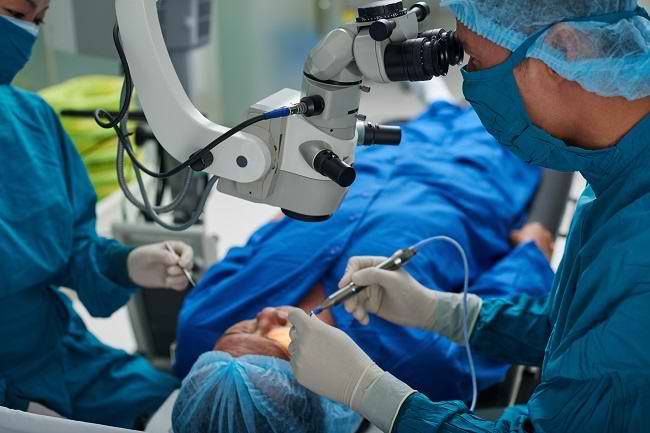small Incision Lenticule Extraction (SMILE) is the operation method which using laser to overcome Minu eyess, either with or without cylinder.Compared to LASIK, the SMILE method of surgery has a number of advantages.
In good vision conditions, light will enter through the cornea and lens of the eye to be refracted right into the retina. However, in people with short-sightedness or nearsightedness, the cornea is disturbed so that the refraction of light is not focused on the retina and causes blurred vision.

SMILE is performed by reshaping the cornea using a laser, so that light can be refracted precisely onto the retina. SMILE aims to improve vision in nearsighted people, either with or without cylinder eyes (astigmatism).
Although both can treat nearsightedness, SMILE is different from LASIK. When compared to LASIK, SMILE has several advantages, namely:
- Does not require making a large incision in the cornea (flap), so there is less risk of causing problems, such as detachment of the cornea from the eyeball and disorders of the corneal nerve
- Less risk of dry eyes after the procedure
- Faster healing time
- More suitable for patients who are actively mobile, because there is no risk of the flap shifting or falling off
SMILE Indication
As previously explained, SMILE is done to fix the nearsightedness problem. Requirements for nearsighted people to be able to undergo SMILE include:
- The degree of nearsightedness is between -1 to -10, with astigmatism between 0–5 diopters
- Patients aged 22 years and over
- The size of the glasses has not changed over the past 1 year
- Overall good eye condition, especially the cornea
SMILE Alert
Patients need to consult a doctor before deciding to undergo SMILE surgery. Patients also need to understand that SMILE does not always produce perfect vision and makes patients not need glasses at all.
In addition, not everyone can undergo SMILE surgery. The following are some of the conditions that make a person unable or necessary to delay the operation:
- Less than 18 years old
- Are pregnant or breastfeeding
- Have unstable glasses minus size in the last year
- Have a history of scar tissue or keloids
- Have a scratch on the cornea (corneal abrasion)
- Have a cornea that is not thick enough
- Suffering from glaucoma or cataracts
- Have you ever had eye surgery?
- Have uncontrolled diabetes
- Suffering from immune system disorders
- Suffering from HIV/AIDS
SMILE preparation
The doctor will ask the patient to undergo a number of examinations below to ensure that SMILE is the right treatment for the patient's complaint:
- Visual function checkThe doctor will measure the severity of the patient's nearsightedness to know for sure whether the patient can undergo SMILE. This examination is also done to ensure the patient's visual acuity is stable.
- Overall eye examThe doctor will make sure there are no other problems with the patient's eyes. This is done to avoid the risk of side effects or complications that may arise during or after surgery.
- Pupil size checkThe ideal pupil size for this procedure is about 6 mm in the dark.
- Examination and measurement of the thickness of the cornea of the eyeThe results of the corneal measurements will be used to adjust the laser during surgery.
After the patient is confirmed to be able to undergo SMILE surgery, the doctor will explain the sequence, benefits, and risks of surgery. Next, the doctor will schedule surgery with the patient.
Patients are advised to be accompanied by family or relatives on the day of surgery. This is so that patients can be taken home after undergoing SMILE.
SMILE procedure
The SMILE procedure generally lasts 10-15 minutes. The following are the steps that doctors do in the SMILE procedure:
- The laser is programmed with precise measurements, according to the size of the patient's cornea.
- The patient's eye will be placed under anesthetic to numb the eye.
- After the anesthetic has worked, the ophthalmologist will place a brace in the eye to prevent the patient from blinking.
- A suction ring is placed in the eye to lift and flatten the cornea, and prevent the eye from moving.
- The laser will make a disc-shaped cut (lenticule) under the surface of the cornea, as well as a small incision in the cornea.
- The doctor will then remove lenticule through the incision that has been made, so that the cornea will get a new shape.
After SMILE
After undergoing the SMILE procedure, the patient may be discharged immediately or may need to stay overnight in the hospital, depending on the condition. In patients who are allowed to go home, doctors usually advise patients to rest completely for at least 1 full day.
Patients also need to regularly use eye drops prescribed by a doctor. This is important to help the recovery process.
The patient's vision will be blurry after surgery, but will gradually improve over time. Most patients can return to activities 1-2 days after surgery. However, patients should keep their eyes out of water for up to 3–5 days.
In most of the patients who underwent SMILE, their vision function became much better, even they did not need glasses. However, some patients may still need glasses during certain activities, such as reading or driving at night.
SMILE risk
Although rare, SMILE can cause side effects like any other surgery. These side effects include:
- Infection
- Inflammation in the surgical area
- Glare vision when in bright places
- Remaining piece of cornea that can be felt in the eye
Patients may also get results that are not as expected, such as blurred vision. However, this condition can be treated with additional glasses, contact lenses, or laser surgery.
In addition to the above side effects, in rare cases, SMILE surgery can lead to more severe complications, such as:
- Vision is worse than before and cannot be helped by wearing glasses or contact lenses
- Blindness









